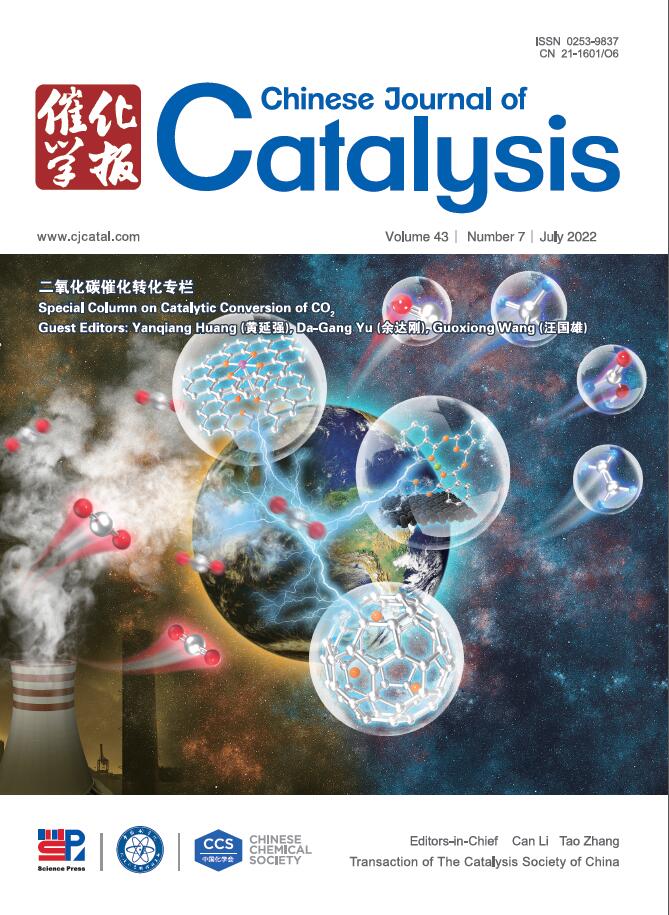全固溶s型异质结,具有可调的内部电场,具有高效的光催化活性
IF 15.7
1区 化学
Q1 CHEMISTRY, APPLIED
引用次数: 0
摘要
开发高效的光催化剂是实现光催化实际应用的关键。s型异质结具有独特的载流子迁移途径、有效的光吸收和高的氧化还原能力,在光催化方面具有很大的潜力。然而,进一步增强s方案的内置电场,加速载流子分离,实现更高的光催化性能仍然是尚未解决的挑战。本文基于连续固溶体的连续可调能带结构,分别以ZnxCd1-xS和Bi2MoyW1-yO6固溶体作为还原和氧化半导体,设计并制备了一种具有可调内电场的0D/2D全固溶体s型异质结。有效光吸收、快速光生载流子分离和高氧化还原电位导联的协同优化可以提高光催化活性。在可见光下,由Zn0.4Cd0.6S量子点(QDs)和Bi2Mo0.2W0.8O6单层构建的S-scheme体系对C2H4的光催化降解率为150.6 × 10-3 min-1,是纯Zn0.4Cd0.6S (9.1 × 10-3 min-1)的16.5倍,是纯Bi2Mo0.2W0.8O6 (2.8 × 10-3 min-1)的53.8倍。由于独特的电荷-载流子迁移途径,ZnxCd1-xS的光腐蚀被进一步抑制。原位辐照x射线光电子能谱、光致发光能谱、时间分辨光致发光能谱、瞬态吸收能谱和电子顺磁共振为界面电荷通过S-scheme途径转移提供了有力证据,而原位漫反射红外傅立叶变换能谱则确定了C2H4降解的反应途径。该新型s型光催化剂在果蔬室温保鲜方面表现出优异的性能和潜在的实际应用前景。本文章由计算机程序翻译,如有差异,请以英文原文为准。
All solid-solution S-scheme heterojunction with adjustable internal electric field for highly efficient photocatalytic activity
Developing an efficient photocatalyst is the key to realize the practical application of photocatalysis. The S-scheme heterojunction has great potential in photocatalysis due to its unique charge-carrier migration pathway, effective light absorption and high redox capacity. However, further enhancing the built-in electric field of the S-scheme, accelerating carrier separation, and achieving higher photocatalytic performance remain unresolved challenges. Herein, based on the continuously adjustable band structure of continuous solid-solution, a novel 0D/2D all solid-solution S-scheme heterojunction with adjustable internal electric field was designed and fabricated by employing a solid-solution of ZnxCd1–xS and Bi2MoyW1–yO6 respectively as reduction and oxidation semiconductors. The synergistic optimization of effective light absorption, fast photogenerated carrier separation, and high redox potential leads can be tuned to promote photocatalytic activity. Under visible light, the S-scheme system constructed by Zn0.4Cd0.6S quantum dot (QDs) and Bi2Mo0.2W0.8O6 monolayer exhibits a high rate for photocatalytic degradation C2H4 (150.6 × 10–3 min–1), which is 16.5 times higher than that of pure Zn0.4Cd0.6S (9.1 × 10–3 min–1) and 53.8 times higher than pure Bi2Mo0.2W0.8O6 (2.8 × 10–3 min–1). Due to the unique charge-carrier migration pathway, photo-corrosion of ZnxCd1–xS is further inhibited simultaneously. In-situ irradiation X-ray photoelectron spectroscopy, photoluminescence spectroscopy, time-resolved photoluminescence, transient absorption spectroscopy and electron paramagnetic resonance provide compelling evidence for interfacial charge transfer via S-scheme pathways, while in-situ diffuse reflectance infrared Fourier transform spectroscopy identifies the reaction pathway for C2H4 degradation. This novel S-scheme photocatalysts demonstrates excellent performance and potential for the practical application of the fruits and vegetables preservation at room temperatures.
求助全文
通过发布文献求助,成功后即可免费获取论文全文。
去求助
来源期刊

Chinese Journal of Catalysis
工程技术-工程:化工
CiteScore
25.80
自引率
10.30%
发文量
235
审稿时长
1.2 months
期刊介绍:
The journal covers a broad scope, encompassing new trends in catalysis for applications in energy production, environmental protection, and the preparation of materials, petroleum chemicals, and fine chemicals. It explores the scientific foundation for preparing and activating catalysts of commercial interest, emphasizing representative models.The focus includes spectroscopic methods for structural characterization, especially in situ techniques, as well as new theoretical methods with practical impact in catalysis and catalytic reactions.The journal delves into the relationship between homogeneous and heterogeneous catalysis and includes theoretical studies on the structure and reactivity of catalysts.Additionally, contributions on photocatalysis, biocatalysis, surface science, and catalysis-related chemical kinetics are welcomed.
 求助内容:
求助内容: 应助结果提醒方式:
应助结果提醒方式:


